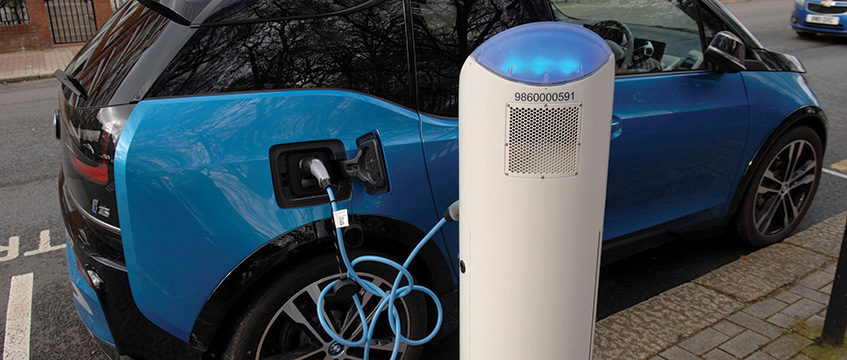With the uptake in electric vehicles (EVs) continuing to gather speed and estimates suggesting there could be up to 36m EVs on the road by 2040, steps need to be taken now to ensure the necessary infrastructure is in place to meet this growing demand.
Why the increase?
- Conscious consumerism Conscious consumers are now more aware of the impact car choice has on the environment. The cost benefits of an EV in the long term are also proving beneficial. Traditional petrolheads Jeremy Clarkson, Richard Hammond and James May are featuring EVs on
The Grand Tour and the FIA Formula E Championship is a motorsport using only electric-powered racing cars. Even Porsche plans to launch its first EV in September. - Government strategy
To reduce emissions and encourage more environmentally friendly alternatives, the government has announced that the sale of new conventional petrol and diesel cars will end by 2040. The measures contained in the Road to Zero Strategy (July 2018) include ensuring all new homes (where appropriate) have a charging point available and Highways England has committed to ensuring that there is a charging point every 20 miles along the strategic road network by 2020. Although most of it is not yet in force, the Automated and Electric Vehicles Act 2018 is the first legislative step towards enshrining EV charging in law. - Driving business With Royal Mail, UKPN, DX and London cabs all increasing their commitment to EVs across their fleets, the UK needs to respond with an increase in the number of electric vehicle charging points (EVCPs) to accommodate growing demand.
Impact on commercial real estate
Figures from the Committee on Climate Change report, Plugging the gap: An assessment of future demand for Britain’s electric vehicle public charging network (January 2018), suggest that the UK needs an additional 25,000 EVCPs by 2030 to match EV demand. This is all very well but with EV owners living in the estimated 43% of households that do not have access to off-street parking, it is landowners, retailers, employers and house builders that need to consider how to incorporate EVCP infrastructure into their new and existing developments and use the investment to differentiate themselves and maintain competitive advantage.
Rethinking the fuel stop
Morrisons is the latest supermarket chain supporting EV drivers. It has announced plans to install 100 rapid chargers by the end of the year, enabling customers to shop in store while their EV recharges in around 20 minutes. This follows Tesco’s announcement that it intends to install 2,400 EVCPs across its UK stores, while pub chain Marstons is currently rolling out 400 EVCPs across its UK sites.
A host of other retailers are pursuing similar plans as they seek to make the best use of the EV driver’s dwell time while they wait for their battery to recharge. Perhaps this is an opportunity to rethink the fuel stop? Internet access, physical activity areas for kids or maybe a drive-in where drivers and families could get something to eat in-car while charging might all draw in consumers.
Legal considerations
Electric mobility has arrived and is here to stay. Here are a few legal points to consider:
1. Getting connected Is consent from the distribution system operator required?
2. Alternative Fuels Infrastructure Regulations 2017 Any new EVCPs must comply with these regulations, which, for example, require that all public charge points provide a pay as you go option.
3. Charging consumers If users are to be charged, any payment scheme will need to comply with consumer laws and an electricity supply licence may be required under the Electricity Act 1989.
4. Health and safety risks While the infrastructure would normally come with a warranty, site owners and operators need to ensure the health and safety risks of installing and using the charge points are managed effectively.
5. Property rights Are there any easements or wayleaves that need to be obtained?
6. Planning permission This is likely to be required, unless the proposed EVCP benefits from permitted development rights.
7. Charging infrastructure equipment ownership Where someone other than the site owner owns and operates the infrastructure, this is likely to necessitate a lease. The consent of any lender or superior landlord may also be required.
8. Tenant installing EVCPs If a tenant wants to install an EVCP it may have an impact on rent and future rent reviews, repairing and insuring responsibilities and reinstatement – what will happen at the end of the lease term?
Looking ahead
There is no denying that EVs are part of our growing infrastructure. Investors and developers need to take stock now to ensure their strategies are fit for the future.
Over the next 10 years, we expect to see more change in the transport sector than we have done in the previous century. Now is the time to consider how such ambitious charging plans can be powered and how we can help our real estate clients
tap into and benefit from a fuel-free future.
Claire Durkin and Alison Spender are senior associates in the commercial real estate team at Cripps, incorporating Pemberton Greenish








